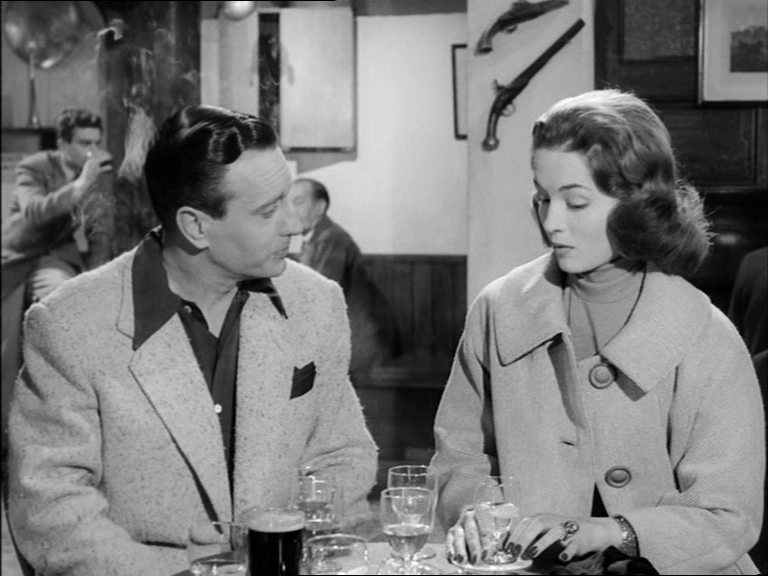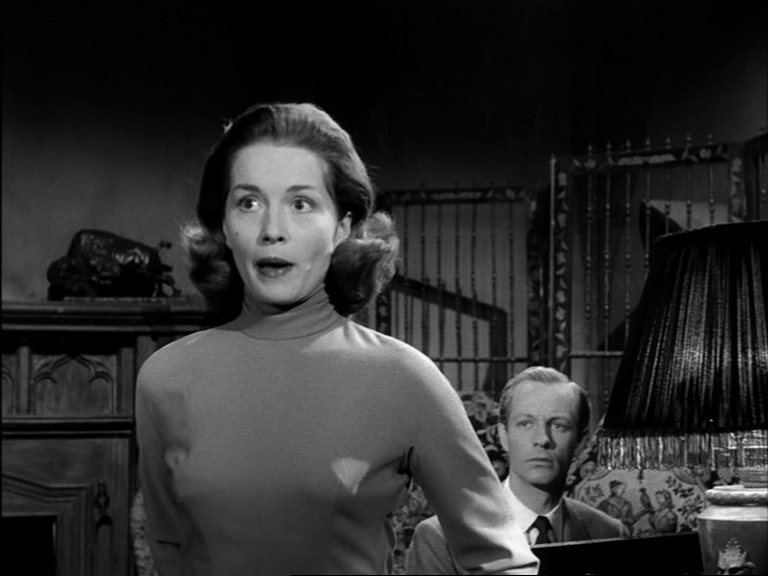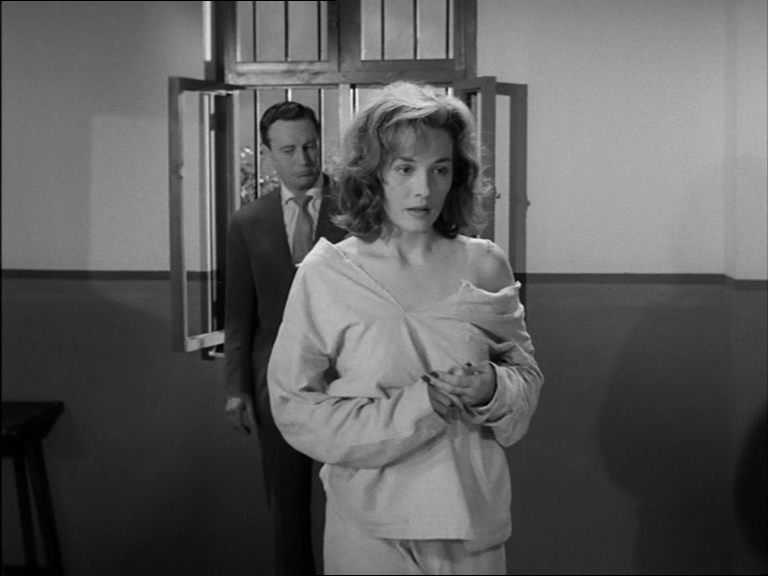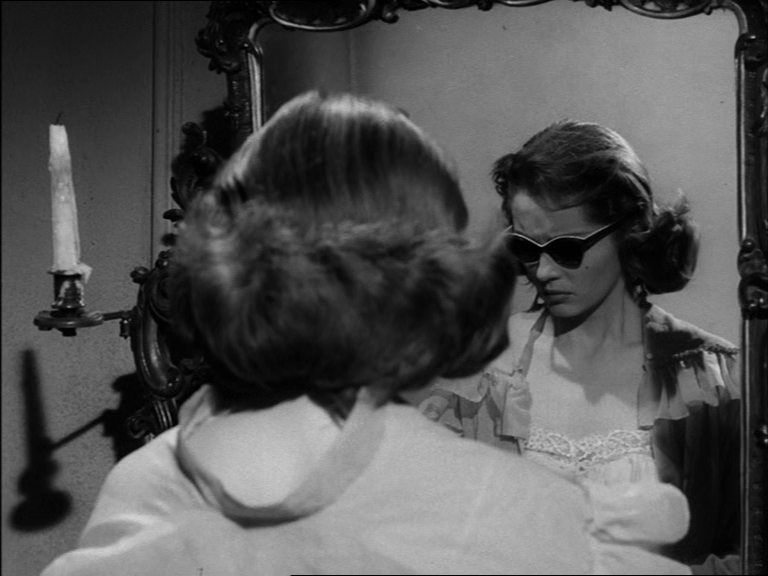|
The Film

Cat Girl (Alfred Shaughnessy, 1957)
 Clearly based on Val Lewton’s iconic 1944 horror film Cat People, even down to a number of setpieces which are almost identical in their staging, Cat Girl (Alfred Shaughnessy, 1957) was a product of AIP’s interest in overseas film markets. Expanding their horizons, American International Pictures coproduced this film in the UK under a similar scheme that enabled them to coproduce Mario Bava’s Le maschera del demonio/Black Sunday (1959) in Italy: AIP would provide a US director or screenwriter and finance a portion of the films’ budgets, and this would enable them to claim ownership of half of the film, thus giving AIP significant distribution rights to the completed picture and enabling them to make a potentially healthy profit whilst minimising the level of risk. Clearly based on Val Lewton’s iconic 1944 horror film Cat People, even down to a number of setpieces which are almost identical in their staging, Cat Girl (Alfred Shaughnessy, 1957) was a product of AIP’s interest in overseas film markets. Expanding their horizons, American International Pictures coproduced this film in the UK under a similar scheme that enabled them to coproduce Mario Bava’s Le maschera del demonio/Black Sunday (1959) in Italy: AIP would provide a US director or screenwriter and finance a portion of the films’ budgets, and this would enable them to claim ownership of half of the film, thus giving AIP significant distribution rights to the completed picture and enabling them to make a potentially healthy profit whilst minimising the level of risk.
In the case of Cat Girl, the film came with a script by American screenwriter Lou Rusoff. The film opens in an isolated country house during a stormy night. Edmund Brandt (Ernest Milton) reveals a leopard in a cage, telling the creature, ‘You must be patient. We will go out as soon as my niece reaches this house’. In a nearby pub, Brandt’s niece Leonora (Barbara Shelley) waits with her husband Richard (Jack May), and her friends Cathy (Paddy Webster) and Allan (John Lee). They are on their way to Brandt’s house: Leonora has received a telegram calling her to Brandt’s home, and she has ignored the demand that she ‘come alone’.
Leonora’s marriage is an unhappy one. She is uninspired by her husband, and as one of her friends notes, Leonora’s marriage is ‘a perfect match Leonora’s money, and Richard’s capacity for spending’. Richard is a gold-digger, inspired only by the possibility that Leonora will inherit a significant sum of money from her uncle, and he is also unfaithful: away from Leonora, he flirts outrageously with Cathy. Before leaving the pub and embarking on the journey to the Brandt house, Leonora encounters Dr Brian Marlowe (Robert Ayres): Leonora and Marlowe apparently had some sort of romantic relationship in their youth, and there is the suggestion that Leonora still hides a desire for Marlowe.
 Reaching the Brandt house, the group are shown their rooms by Brandt’s housekeeper Anna (Lily Kann). During the night, Brandt calls Leonora to the room in which he keeps the leopard. He tells her of the family curse, ‘passed on to my heir, my nearest blood relative, my brother’s only child: my dear Leonora [….] To be condemned to live a life of horror and anguish, to have the form and intellect of a man yet the cunning and savagery and blood lust of these creatures [wild cats]’. Brandt tells Leonora, ‘From now on to the end of your life, there will be two of you as there are two of me: two separate entities, distinguishable from each other yet never apart’: the leopard will become ‘the servant of your mind and the strength of your body’. Reaching the Brandt house, the group are shown their rooms by Brandt’s housekeeper Anna (Lily Kann). During the night, Brandt calls Leonora to the room in which he keeps the leopard. He tells her of the family curse, ‘passed on to my heir, my nearest blood relative, my brother’s only child: my dear Leonora [….] To be condemned to live a life of horror and anguish, to have the form and intellect of a man yet the cunning and savagery and blood lust of these creatures [wild cats]’. Brandt tells Leonora, ‘From now on to the end of your life, there will be two of you as there are two of me: two separate entities, distinguishable from each other yet never apart’: the leopard will become ‘the servant of your mind and the strength of your body’.
Shortly after, Brandt deliberately smashes a figurine that appears to symbolize his attachment to the leopard, and seemingly as a consequence he is killed by the creature. The police investigate but find no evidence of foul play. Following her uncle’s death, Leonora experiences a strange bloodlust and also sees an increase in her desire for Brian. When she encounters Richard and Cathy in a romantic embrace, the leopard kills the pair. Under Brian’s care, Leonora is placed in a mental institution: although she believes the leopard is acting as the agent of her will, Brian is convinced she is suffering from a mental illness which is curable. Brian attempts to convince Leonora that her connection with the leopard is all in her mind, but Leonora becomes increasingly convinced that she and the animal share a psychic bond.
In Fearing the Dark: The Val Lewton Career (2003), Edmund G Bansak notes that Cat Girl (Alfred Shaughnessy, 1957) is the second ‘most overt [Val] Lewton imitation’, following in the footsteps of Jacques Tourneur’s ‘classic Lewton homage The Curse of the Demon [1957]’ (503). A third British film, Sidney Hayers’ Night of the Eagle (1962), also showed evidence of a heavy indebtedness to Lewton’s films and their approach to the horror genre, and as Peter Hutchings has suggested this is represented through these three pictures’ ambiguity in relation to the depiction of their respective monsters: like Lewton’s films, in these three British horror films a question hangs over whether or not the monster is ‘a real, independent entity or an externalisation of a psychological state’ (1993: 92). This, combined with the films’ noir-like use of chiaroscuro lighting, ensured that these three pictures were, ‘like the disturbing and provocative self-reflexivity of Peeping Tom [Michael Powell, 1960], alien’ to the approach of the Hammer horror films being produced at the same time, which was defined by a ‘certainty that it projected’ about the various horrors on which the films (The Curse of Frankenstein, Terence Fisher, 1957; Dracula, Terence Fisher, 1958) were based (ibid.).
 Bansak notes that Cat Girl’s ‘study in feline dementia did little to hide its Cat People origins’ (Bansak, op cit.: 503). Like Lewton’s film, Cat Girl is ‘a study in female psychosexual pathology’, with Leonora depicted in the early sequences as ‘timid’ and ‘sexually repressed’ but transformed during the film, much as Barbara Shelley’s character is memorably transformed by the vampire’s bite in Terence Fisher’s Dracula: Prince of Darkness (1964), into ‘an assertive, homicidal femme fatale whose bestial instincts compel her to murder her husband and any other romantic rivals’ (Meehan, 2010: 152). In both films, the suggestion of repressed, aggressive sexuality, embodied by Shelley and exaggerated in her transformation from prim lady to seductive vamp, offers a challenge to stereotypical depictions of repressive British (bourgeois) cultural identity, foregrounding ‘the power of sexual promiscuity in the late 1950s to subvert the traditional British class structure’ (Lane Roth, quoted in Brode, 2013: 12). Cat Girl thus essays a duality of the self, as outlined in Brandt’s words to Leonora (‘From now on to the end of your life, there will be two of you as there are two of me: two separate entities, distinguishable from each other yet never apart’). In this context, the second self, symbolised by the leopard, represents Leonora’s repressed sexuality and her capacity for violence; as the narrative progresses, she becomes increasingly closer to this aspect of her personality, expressing her desire for Brian, her former lover, in an overt manner (‘I never stopped loving you’, she tells him at one point: ‘Now I need you’). Bansak notes that Cat Girl’s ‘study in feline dementia did little to hide its Cat People origins’ (Bansak, op cit.: 503). Like Lewton’s film, Cat Girl is ‘a study in female psychosexual pathology’, with Leonora depicted in the early sequences as ‘timid’ and ‘sexually repressed’ but transformed during the film, much as Barbara Shelley’s character is memorably transformed by the vampire’s bite in Terence Fisher’s Dracula: Prince of Darkness (1964), into ‘an assertive, homicidal femme fatale whose bestial instincts compel her to murder her husband and any other romantic rivals’ (Meehan, 2010: 152). In both films, the suggestion of repressed, aggressive sexuality, embodied by Shelley and exaggerated in her transformation from prim lady to seductive vamp, offers a challenge to stereotypical depictions of repressive British (bourgeois) cultural identity, foregrounding ‘the power of sexual promiscuity in the late 1950s to subvert the traditional British class structure’ (Lane Roth, quoted in Brode, 2013: 12). Cat Girl thus essays a duality of the self, as outlined in Brandt’s words to Leonora (‘From now on to the end of your life, there will be two of you as there are two of me: two separate entities, distinguishable from each other yet never apart’). In this context, the second self, symbolised by the leopard, represents Leonora’s repressed sexuality and her capacity for violence; as the narrative progresses, she becomes increasingly closer to this aspect of her personality, expressing her desire for Brian, her former lover, in an overt manner (‘I never stopped loving you’, she tells him at one point: ‘Now I need you’).
Suggesting that Cat Girl offers little that is memorable, Bansak nevertheless notes how impressive Barbara Shelley is in her role, asserting that she ‘shows a remarkable sense of presence’ which ‘almost makes up for the film’s many deficiencies’ (Bansak, op cit.: 503). As Kim Newman has highlighted, in common with other films indebted to Cat People (such as Edgar Ulmer’s Daughter of Jekyll, 1957, and Eric Kenton’s The Cat Creeps, 1946), Cat Girl features a similar narrative premise to Lewton’s iconic film (‘heroine is afraid she has inherited a tendency to turn into a monster’) and, though they ‘try to hide the Tourneur-Musuruca shadowy horror noir style’, the films ‘still feel obliged to toss in fur-face effects and use a gothic old dark house setting with out-of-stock melodrama characters’ (Newman, 2003: 570).
As Bansak suggests in his book about Lewton, Cat Girl’s changes to the basic premise of Val Lewton’s Cat People, on which it is clearly based, are sometimes slightly confusing in a narrative sense. Where in Lewton’s Cat People, the curse transformed the sufferer into a feline, in Shaughnessy’s Cat Girl Shelley’s Leonora does not change shape but rather has a spotted leopard work, ‘controlled by her repressed jealousy’, act as the agent of her will (Bansak, op cit.: 504). The creature functions as a kind of ‘totem animal’: a ‘folkloric concept’ in which an animal acts as a ‘guardian who protects an individual with its power’ (in this sense, even a film such as Wes Craven’s The Serpent and the Rainbow, 1987, in whose climax the protagonist is protected by his ‘totem animal’, a leopard, demonstrates an indebtedness to Lewton’s Cat People) (Meehan, op cit.: 152). Bansak notes that, ‘[a]t times we feel she is seeing through the eyes of the predator, but we are never quite sure [….] Whenever Leonora is in one of her spells, the camera repeatedly cuts back and forth between Shelley and the escaped leopard, so they are clearly established as separate entities; yet the cross-cutting is so disorienting that it diffuses any potential suspense’ (Bansak, op cit.: 504).
 Rusoff’s original script for Cat Girl was apparently more heavily indebted to Lewton’s Cat People than the finished film: in the script, Shelley’s character does indeed transform into a feline. However, Alfred Shaughnessy felt that these supernatural elements should be downplayed, ‘turning the lead character from a “were-cat” into a run-of-the-mill psychopath who only thought she could change into a fanged, feline friend’ (Palmer, 1997: 128). Shaughnessy’s changes, Randy Palmer argues, made the film ‘a great deal more complex’ and, by downplaying the more fantastical elements and turning the film from a supernatural horror picture into ‘a psychological nightmare’, also lent an element of ‘respectability’ to the production that appealed to Barbara Shelley – for whom this was her first English film (ibid.). Rusoff’s original script for Cat Girl was apparently more heavily indebted to Lewton’s Cat People than the finished film: in the script, Shelley’s character does indeed transform into a feline. However, Alfred Shaughnessy felt that these supernatural elements should be downplayed, ‘turning the lead character from a “were-cat” into a run-of-the-mill psychopath who only thought she could change into a fanged, feline friend’ (Palmer, 1997: 128). Shaughnessy’s changes, Randy Palmer argues, made the film ‘a great deal more complex’ and, by downplaying the more fantastical elements and turning the film from a supernatural horror picture into ‘a psychological nightmare’, also lent an element of ‘respectability’ to the production that appealed to Barbara Shelley – for whom this was her first English film (ibid.).
Randy Palmer suggests that Cat Girl is ‘moody’ but ‘too slow-moving for its own good’ (op cit.: 129). AIP’s Samuel Z Arkoff was reputedly strongly disappointed in the film when it was screened for him, asking ‘Where’s the monster?’ and asserting ‘We can’t even release this film. It’s so awful’ (Arkoff, quoted in ibid.). In an attempt to salvage what Arkoff considered to be a bad picture, AIP asked Paul Blaisdell to deliver some special effects makeup of a ‘cat-woman’ that could be used to produce a couple of insert shots which would be used in two sequences within the film (the obligatory ‘fur-face effects’ to which Kim Newman alluded to in the quote above): when Leonora finds herself in the psychiatric hospital and, gazing into the mirror, sees her reflection as half-woman and half-cat; and another scene, which apparently never made its way into the final cut of the film, that would have depicted Leonora during some sort of transformation (ibid.: 129-30). These inserts appeared in the American version of the film, but not the British cut of the picture - which remained much more ambiguous regarding the issue of whether or not the protagonist is in fact afflicted with a curse that sees her transform into a wild animal.
This disc runs for 72:53 mins (PAL) and contains the UK version only (ie, the cut of the film without the brief 'transformation' inserts).
Video
The film is presented in its original aspect ratio of 1.33:1. The monochrome image is detailed and displays good contrast. Tonality is strong. The print is surprisingly clean.

The film is uncut and runs for 72:53 PAL.
Audio
Audio is presented via a two-channel mono track, which is also clean and audible throughout. Sadly, there are no subtitles.
Extras
The disc also includes the film’s trailer (2:01) and a stills gallery (1:49). The pressbook is also included on the disc (as a PDF file).
Overall
While not groundbreaking, Cat Girl is an interesting horror film that is worth viewing. Shelley’s performance is very strong, and in fact she holds the film together. The ambiguity surrounding the connection that exists between Leonora and the leopard is well-handled. However, the film displays a heavy debt to Lewton’s Cat People, with a number of sequences playing out as (pale) imitations of key scenes in Lewton’s film. The presentation of the film on this disc is very good.
Bibliography:
Bansak, Edmund G, 2003: Fearing the Dark: The Val Lewton Career. London: McFarland
Brode, Douglas, 2013: ‘Introduction: “Lamia and Lilith LIVE! (or at Least are Undead)’. In: Brode, Douglas & Deyneka, Leah (eds), 2013: Dracula’s Daughters: The Female Vampire on Film. London: Scarecrow Press
Hutchings, Peter, 1993: Hammer and Beyond: The British Horror Film. Manchester University Press
Meehan, Paul, 2010: Horror Noir: Where Cinema’s Dark Sisters Meet. London: McFarland
Newman, Kim, 2003: ‘Cat People’. In: White, Rob & Buscombe, Edward, 2003: British Film Institute Film Classics, Volume 1. London: Taylor & Hudson: 550-575
Palmer, Randy, 1997: Paul Blaisdell, Monster Maker: A Biography of the “B” Movie Makeup and Special Effects Artist. London: McFarland
|

